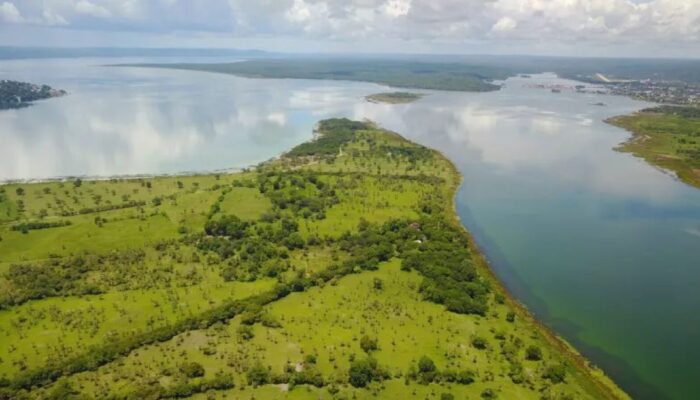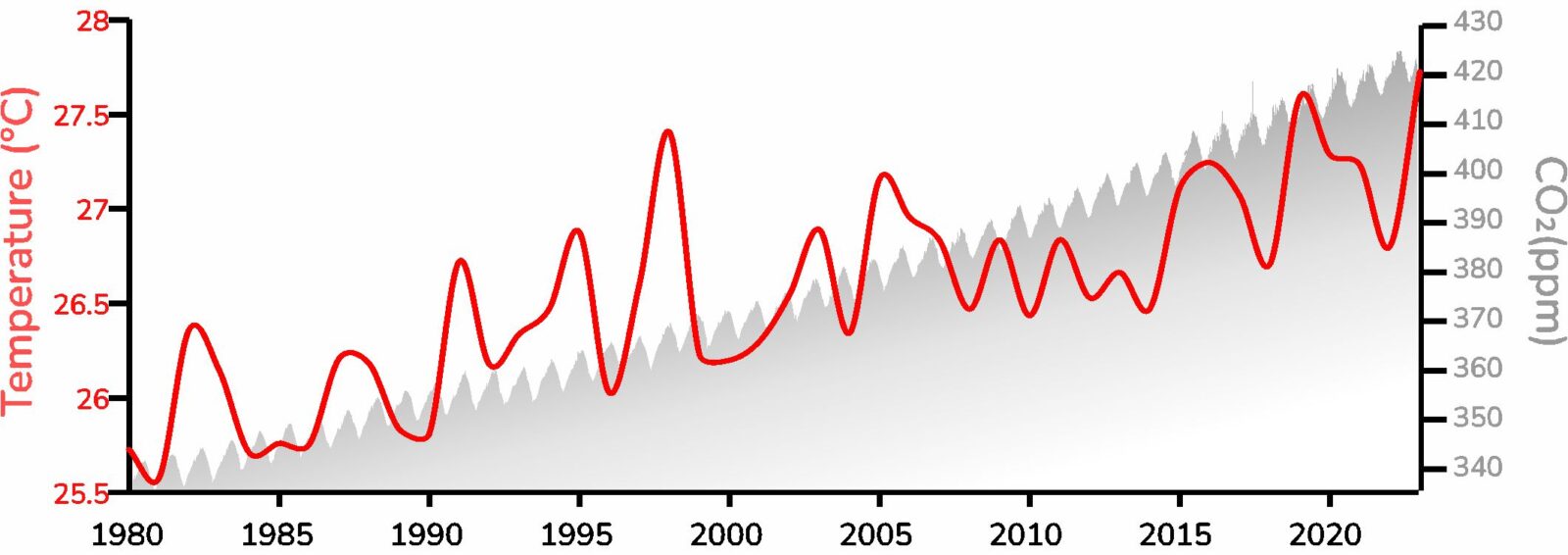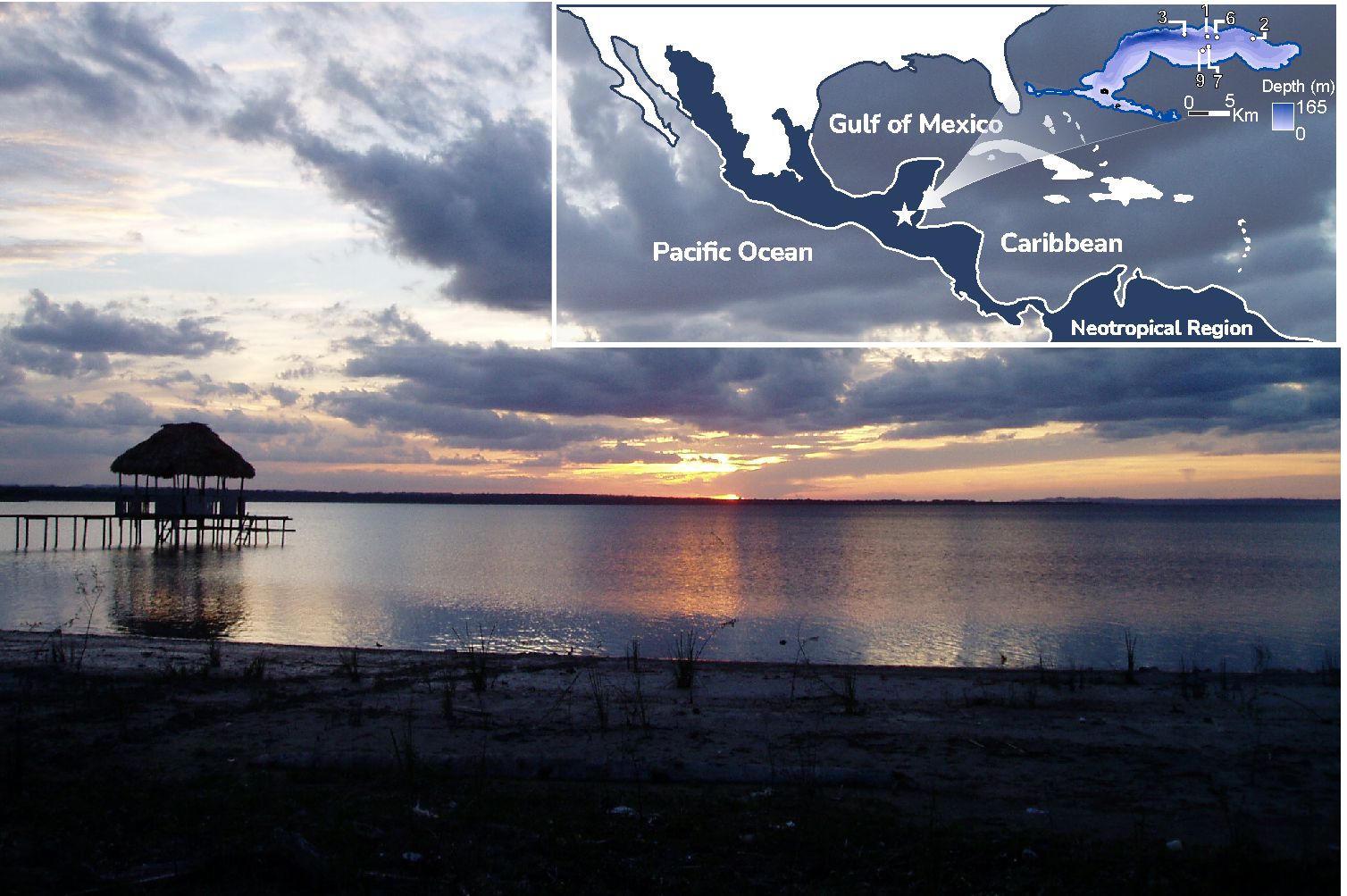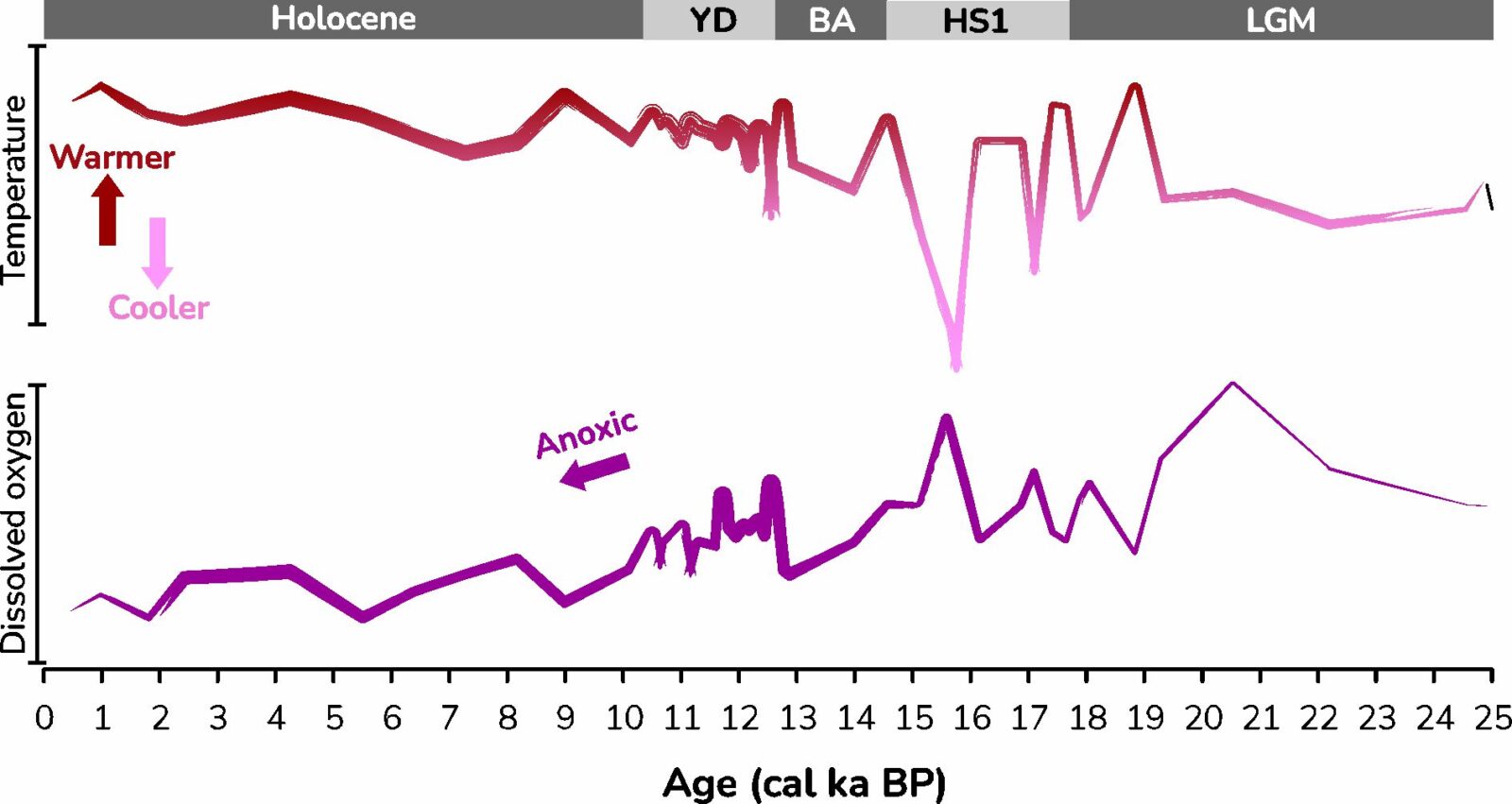
- Past and present global warming: its effect on the tropics
According to meteorological data and climate models, global temperatures have increased by up to 1.1 °C since 1960 because of rising atmospheric greenhouse gas concentrations, including an increase in CO₂ concentrations by up to 200 ppm. In some regions, such as the tropics, home to over 40% of the world’s population, warming has reached up to 2 °C compared to preindustrial values (INSIVUMEH, 2024; Fig. 1). This phenomenon can cause drastic changes in rainfall regimes and disrupt sensitive ecosystems such as lakes, which serve as vital freshwater sources for local communities. However, warming of this magnitude is not unprecedented. Over the past 24,000 years, from the Last Glacial Maximum (LGM) to the present, the Holocene, global temperatures have increased by approximately 7 °C. This rise was driven by complex interactions within the global climate system, orbital forcing mechanisms, and a significant increase in atmospheric CO₂ (Osman et al., 2021). Understanding how past warming impacted aquatic systems, particularly in understudied tropical regions, thus, may provide clues for our near future considering anthropogenic warming.

Annual mean atmospheric temperature since 1980 in the Lake Petén Itzá region (red line), recorded at the “Flores-Aeropuerto” weather station, located ~5 km from the drilling site (data provided by the National Institute for Seismology, Volcanology, Meteorology, and Hydrology [INSIVUMEH], November 2024). In gray, atmospheric CO₂ concentrations (ppm) based on in situ measurements from Mauna Loa Observatory, Hawaii (source: https://gml.noaa.gov/ccgg/trends/).
Despite the recognized importance of the tropics for understanding the magnitude and pace of post-glacial warming, most studies have focused on marine sediment sequences (Lea et al., 2003), which suggest a warming of around 2 °C and have been widely used in global climate modelling. On land, however, several records in regions such as eastern Africa estimate a more substantial warming of 3 to 4 °C (Tierney et al., 2010; Bauersachs et al., 2021). Very little is known about lowland Central America, and the few available records show conflicting results and pronounced millennial-scale variability during the LGM-Holocene transition, patterns that are not observed in other tropical records. In this context, Lake Petén Itzá, located in northern Guatemala, emerges as a key site for resolving such discrepancies and for improving our understanding of how the Caribbean region connects with other tropical and high-latitude regions.
2. Lake Petén Itzá: a key paleoclimate site
Lake Petén Itzá lies in lowland Central America, a region strongly influenced by climate drivers such as the Intertropical Convergence Zone (ITCZ) and the Atlantic Meridional Overturning Circulation (AMOC), which supply moisture and heat to the region. It is one of the deepest and largest lakes in the area, reaching up to 165 m depth in the north and covering about 114 km² (Fig. 2). Since the 1980s, the lake has been the focus of limnological studies, and several campaigns have confirmed that it preserves hemispheric-scale climate variability in high-resolution.
In 2006, the lake was drilled by the International Continental Scientific Drilling Program (ICDP) and other associated partners (Hodell et al., 2006). The recovered sediments reach depths of 135 m below the lake floor, yielding a climate record of up to 400,000 years (Martínez-Abarca et al., 2024). The uppermost 25 m, corresponding to the LGM and the Holocene, are well characterized in terms of stratigraphy and lithology. These deposits alternate between semi-laminated silty clays rich in organic matter, accumulated during wet periods such as the LGM (24–17.9 ka BP), the Bølling-Allerød (14.6–12.8 ka BP), and the Holocene (last 10.7 kyr); and massive, fine-grained sand layers rich in gypsum, associated with dry periods like Heinrich Stadial 1 (17.9–14.6 ka BP) and the Younger Dryas (12.8–10.7 ka BP).

Figure 2: Photograph of a sunset on the shore of Lake Petén Itzá (credit: Dr. Mark Brenner, 2006). The upper right panel shows the lake’s location within the Neotropical region (dark blue area), as well as its bathymetry. Lines indicate the drilling sites of the ICDP campaign in 2006.
Several efforts have been made to reconstruct regional temperatures using pollen-based calibrations and stable isotope thermometry in ostracod and gastropod shells. However, results differ by up to 10 °C during dry periods, exceeding the expected uncertainty ranges of both methods (Grauel et al., 2016). This highlights the need for new approaches to reconstruct temperature as well as other limnological variables such as dissolved oxygen, pH, and water depth.
3. Reconstructing past temperature: a lipid biomarker approach
The use of lipid biomarkers has gained popularity over the past two decades due to their excellent preservation in lake sediments, and their utility in reconstructing environmental parameters such as temperature, pH, dissolved oxygen, alkalinity, the type and origin of organic matter, forest fires, and human activities. Among the different types of lipid biomarkers, our research on Lake Petén Itzá focuses, among others, on Glycerol Dialkyl Glycerol Tetraethers (GDGTs; see McClymont et al., 2023). These are divided into two main groups: isoprenoid GDGTs (isoGDGTs), produced by Archaea, and branched GDGTs (brGDGTs), produced by Acidobacteria. These lipids are key components of microbial cell membranes, where they provide structural stability in response to environmental conditions.

Figure 3: Examples of the chemical structure of Glycerol Dialkyl Glycerol Tetraethers (GDGTs). In red are branched GDGTs (brGDGTs), illustrating brGDGT-Ia and brGDGT-Ib. In blue are isoprenoid GDGTs (isoGDGTs), represented by isoGDGT-1 and isoGDGT-2. Key components of their chemical structure, which are relevant to the reconstruction of temperature and/or other environmental parameters, are labeled.
Both iso- and brGDGTs are composed of two hydrocarbon chains linked by glycerol molecules and contain different methyl (CH₃) groups (Fig. 3). IsoGDGTs consist of isoprenoid chains and varying numbers of cyclopentane rings (usually 0 to 4). In contrast, brGDGTs mostly lack cyclopentane rings and differ based on the number and position of methyl groups. The abundance and distribution of these compounds in sediments reflect the conditions of the lake or soil at the time of deposition. Over the past two decades, indices derived from GDGTs, calibration functions, and machine learning approaches have been developed to estimate temperature and pH (Weijers et al., 2007), or dissolved oxygen (Raberg et al., 2021) in both lacustrine and terrestrial environments.
4. What does Lake Petén Itzá tell us about past temperatures and limnological variables?
The preliminary brGDGTs results from this research in Lake Petén Itzá—conducted in collaboration with Prof. Thorsten Bauersachs (Aachen University, Germany), Prof. Antje Schwalb (TU Braunschweig, Germany), and Dr. Liseth Pérez (Kiel University, Germany)—show patterns consistent with previously published studies and are currently under active discussion (Fig. 4). We provide first continuous temperature and dissolved oxygen estimates since the LGM, aiming to better understand the influence of hemispheric climate on the Caribbean region and its connection to other tropical climate records.
Over the past 24,000 years, our data suggest significantly lower temperatures during the LGM, in contrast with current climate models that may underestimate continental temperatures in the tropics. The deglaciation is followed by a millennial-scale temperature variability, which we tentatively attribute to changes in the strength of the AMOC as a heat distributor in the region. A progressive warming is observed throughout the Holocene. In addition, we detect a long-term decrease in bottom-water oxygen concentrations since 24 ka, possibly associated with increasingly humid conditions, higher precipitation, and deepening of the water column, which promotes water column stratification and in turn bottom water anoxia through organic matter degradation.
Although several aspects of our interpretation remain under refinement, we anticipate that our findings will be key to understanding the dynamics of tropical aquatic ecosystems under future global warming scenarios and will provide critical data for climate models extending back to the LGM.

Figure 4: Preliminary trends in atmospheric temperature and dissolved oxygen reconstructed based on brGDGTs, covering the Last Glacial Maximum (LGM), the deglaciation (HS1, BA, YD), and the Holocene. Low temperatures and oxygenated bottom waters dominate during the LGM and Heinrich Stadial 1 (HS1), whereas the Holocene in Lake Petén Itzá is characterized by higher temperatures and anoxic deep-water conditions.
Acknowledgments
Many thanks to all the collaborators of this project: Thorsten Bauersachs, Liseth Pérez, Antje Schwalb, Frederik Schenk, Christian Hallmann, Lorenz Schwark, and all our colleagues and institutions involved in the Lake Petén Itzá Drilling Project (PISDP). Funding was provided by ICDP, DFG, and NSF, with analytical support from RWTH Aachen University, TU Braunschweig, and the LIAG Institute for Applied Geophysics.
References
Bauersachs, T., Russell, J.M., Evans, T.W., Schwalb, A., Schwark, L., 2021. A heterocyte glycolipid-based calibration to reconstruct past continental climate change. Nat. Commun. 12, 2406. https://doi.org/10.1038/s41467-021-22739-3
Grauel, A.-L., Hodell, D.A., Bernasconi, S.M., 2016. Quantitative estimates of tropical temperature change in lowland Central America during the last 42 ka. Earth Planet. Sci. Lett. 438, 37–46. https://doi.org/10.1016/j.epsl.2016.01.001
Hodell, D., Anselmetti, F., Brenner, M., Ariztegui, D., the PISDP Scientific Party, 2006. The lake petén itzá scientific drilling project. Sci. Drill. https://doi.org/10.2204/iodp.sd.3.02.2006
Lea, D.W., Pak, D.K., Peterson, L.C., Hughen, K.A., 2003. Synchroneity of tropical and high-latitude Atlantic temperatures over the last glacial termination. Science 301, 1361–1364. https://doi.org/10.1126/science.1088470
Martínez-Abarca, R., Pérez, L., Bauersachs, T., Schenk, F., Kutterolf, S., Brenner, M., Guilderson, T., Correa-Metrio, A., Anselmetti, F.S., Brown, R., Ariztegui, D., Macario-González, L., Cruz-Silva, E., Beltran-Martinez, J.C., Bush, M., Stockhecke, M., Curtis, J., Schwalb, A., 2024. Precipitation variability and environmental change across late Quaternary glacial-interglacial cycles in lowland Central America: Insights from Lake Petén Itzá (Guatemala) sediments. Quat. Sci. Rev. 344, 108985. https://doi.org/10.1016/j.quascirev.2024.108985
McClymont, E.L., Mackay, H., Stevenson, M.A., Damm-Johnsen, T., Honan, E.M., Penny, C.E., Cole, Y.A., 2023. Biomarker proxies for reconstructing Quaternary climate and environmental change. J. Quat. Sci. 38, 991–1024. https://doi.org/10.1002/jqs.3559
Osman, M.B., Tierney, J.E., Zhu, J., Tardif, R., Hakim, G.J., King, J., Poulsen, C.J., 2021. Globally resolved surface temperatures since the Last Glacial Maximum. Nature 599, 239–244. https://doi.org/10.1038/s41586-021-03984-4
Raberg, J.H., Harning, D.J., Crump, S.E., de Wet, G., Blumm, A., Kopf, S., Geirsdóttir, Á., Miller, G.H., Sepúlveda, J., 2021. Revised fractional abundances and warm-season temperatures substantially improve brGDGT calibrations in lake sediments. Biogeosciences 18, 3579–3603. https://doi.org/10.5194/bg-18-3579-2021
Tierney, J.E., Russell, J.M., Huang, Y., 2010. A molecular perspective on Late Quaternary climate and vegetation change in the Lake Tanganyika basin, East Africa. Quat. Sci. Rev. 29, 787–800. https://doi.org/10.1016/j.quascirev.2009.11.030
Weijers, J.W.H., Schouten, S., van den Donker, J.C., Hopmans, E.C., Sinninghe Damsté, J.S., 2007. Environmental controls on bacterial tetraether membrane lipid distribution in soils. Geochim. Cosmochim. Acta 71, 703–713. https://doi.org/10.1016/j.gca.2006.10.003
